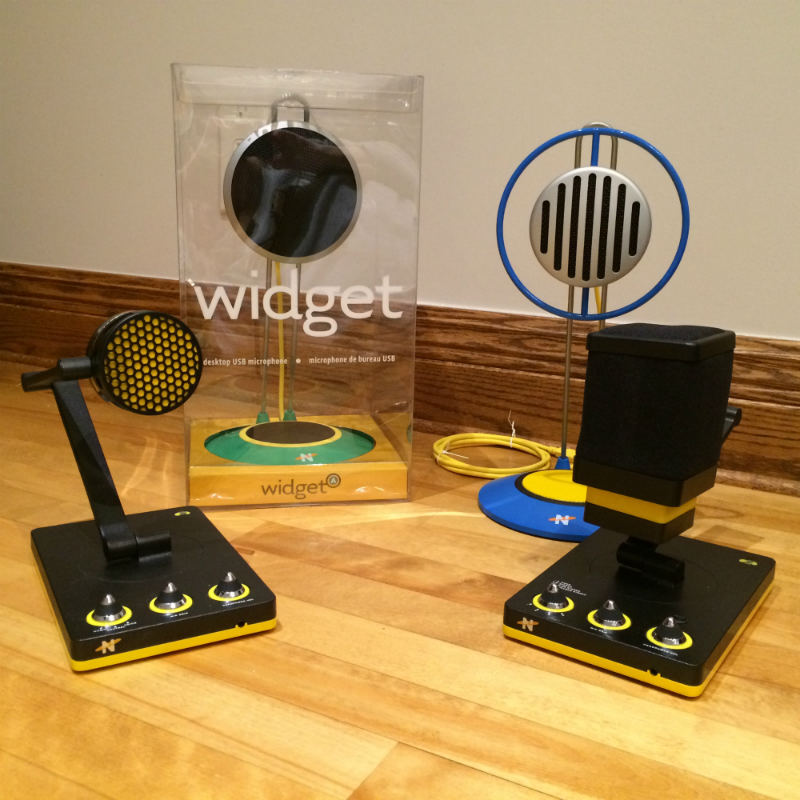 With the ever-growing popularity of home-recording and podcasting, the range of microphones is getting wider and wider. So much, that some manufacturers have started to focus on the style and packaging of their products to stand out. Enter Neat microphones—Gibson’s latest division led by the great people that brought us the beloved Blue mics.
With the ever-growing popularity of home-recording and podcasting, the range of microphones is getting wider and wider. So much, that some manufacturers have started to focus on the style and packaging of their products to stand out. Enter Neat microphones—Gibson’s latest division led by the great people that brought us the beloved Blue mics.
For this blog entry, I’m reviewing the bee colony themed Bumblebee and Beecaster, as well as the futuristic Widget A and C. Being all USB-connected, no audio interface is required to use them with your computer. Read on to find out if their stylish appearance matches up with today’s standards of recording.
Bumblebee
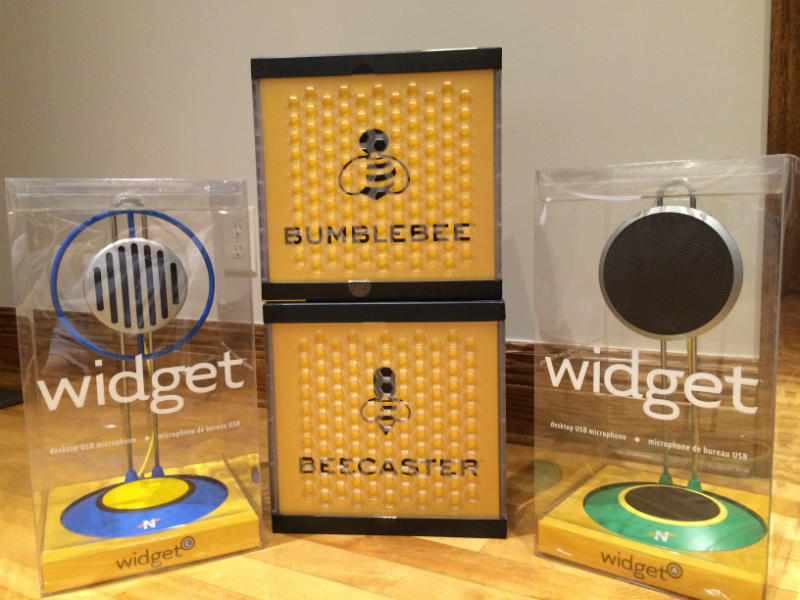 This first microphone ships in a wonderful beehive themed crate that will instantly capture anyone’s attention. The plastic box filled with honeycomb-shaped holes is reusable and quite handy for storing other recording accessories. Inside, you will find a hexagon-shaped manual that is well laid-out and quite informative. Neat thoughtfully includes a few helpful tips for recording various sources and applying the microphone’s different modes. Additionally, the company’s eco-friendliness is solidified with their invitation to get involved in the preservation of the bee population. Apart from the instructions, you will find a USB cable to connect the mic to your computer, a decorative honeybee vinyl figurine and a very convenient pop-filter, which is custom made for this microphone model.
This first microphone ships in a wonderful beehive themed crate that will instantly capture anyone’s attention. The plastic box filled with honeycomb-shaped holes is reusable and quite handy for storing other recording accessories. Inside, you will find a hexagon-shaped manual that is well laid-out and quite informative. Neat thoughtfully includes a few helpful tips for recording various sources and applying the microphone’s different modes. Additionally, the company’s eco-friendliness is solidified with their invitation to get involved in the preservation of the bee population. Apart from the instructions, you will find a USB cable to connect the mic to your computer, a decorative honeybee vinyl figurine and a very convenient pop-filter, which is custom made for this microphone model.
The mic itself is very sturdy and mounted on a trustworthy arm that bends and turns on its base. While I didn’t have any trouble adjusting the position of the microphone to my liking, the capsule itself doesn’t rotate much, which is counterintuitive. Additionally, being permanently fixed on its boom-arm, the Bumblebee cannot be mounted on a regular stand. However, the condenser container is internally shock-mounted, eliminating the need to buy additional accessories. The base includes the USB output, a headphone output and volume adjustment, the microphone gain level and 3 voicing possibilities: “Music”, “Neutral” and “Voice”.
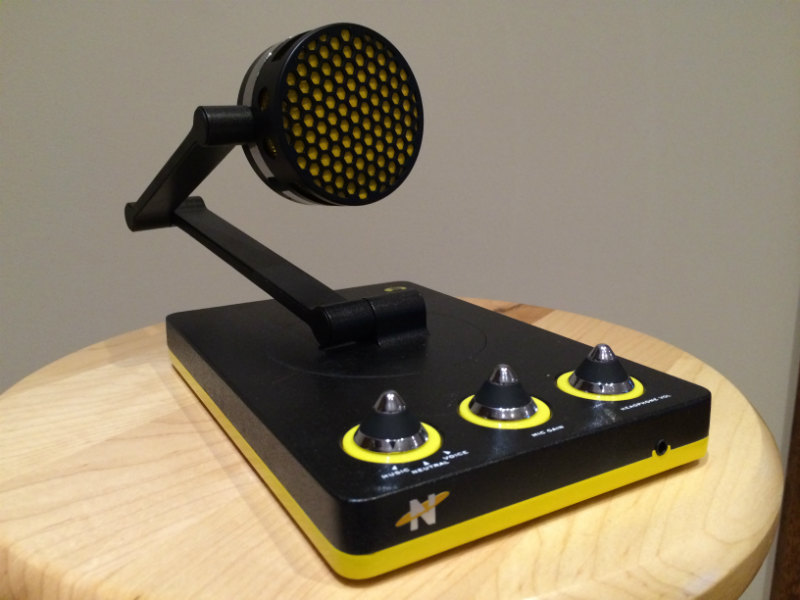 These three options offer a lot of versatility for this affordable mic. On the neutral setting, things are as flat as they can get and offer a good result ready to be massaged with hardware or software equalization. Recordings in this mode seemed to be quite faithful to the original timbres, without any exaggerated frequencies. The voice position noticeably increases clarity and presence by boosting a very wide range of middle frequencies. This is perfect for someone who records podcasts and wants a quick solution to bring the voice to the forefront of a mix. Finally, the music EQ clears a lot of the mids and enhances lows and highs – pretty useful when recording an accompanying instrument. Also, by talking closer to the microphone in this mode, air and richness is added to the voice, helping the user to achieve an intimate sound.
These three options offer a lot of versatility for this affordable mic. On the neutral setting, things are as flat as they can get and offer a good result ready to be massaged with hardware or software equalization. Recordings in this mode seemed to be quite faithful to the original timbres, without any exaggerated frequencies. The voice position noticeably increases clarity and presence by boosting a very wide range of middle frequencies. This is perfect for someone who records podcasts and wants a quick solution to bring the voice to the forefront of a mix. Finally, the music EQ clears a lot of the mids and enhances lows and highs – pretty useful when recording an accompanying instrument. Also, by talking closer to the microphone in this mode, air and richness is added to the voice, helping the user to achieve an intimate sound.
This soundcloud clip demonstrates how these modes affect speech.
This one compares the effects of the neutral EQ and then the music setting on acoustic guitar.
Beecaster
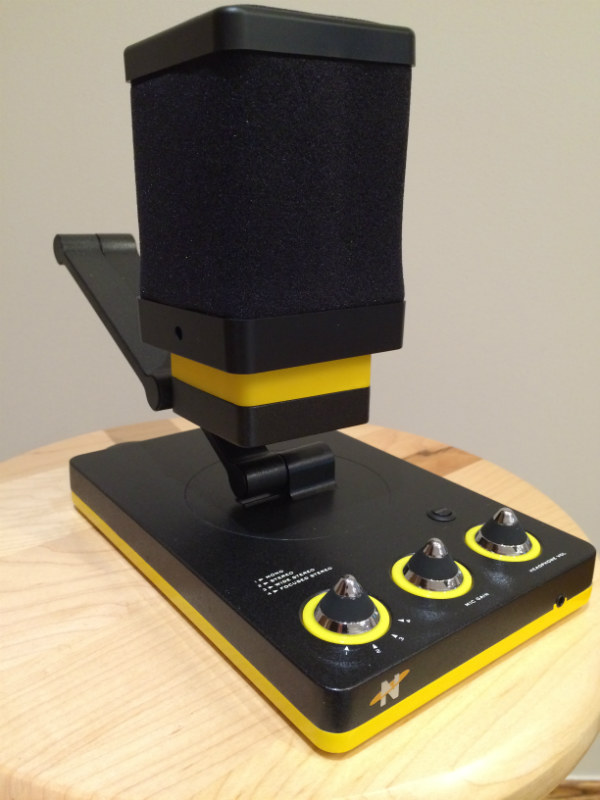 The Beecaster comes in the same type of packaging as its sibling. Its contents are very similar, the difference being the vinyl bee figurine, which is specific to each model of the product range. While this microphone has a large diaphragm, it has exactly the same specifications as the Bumblebee and sounds quite similar. In addition to a useful mute switch, the main difference between both models is the fact that while the Bumblebee had 3 different EQ options, the Beecaster has 4 sonic image options. Thanks to onboard processing, this microphone offers different width options for your recordings with only one condenser inside. Also, both mics share the same drivers, so no separate installation was required when I plugged in the second microphone.
The Beecaster comes in the same type of packaging as its sibling. Its contents are very similar, the difference being the vinyl bee figurine, which is specific to each model of the product range. While this microphone has a large diaphragm, it has exactly the same specifications as the Bumblebee and sounds quite similar. In addition to a useful mute switch, the main difference between both models is the fact that while the Bumblebee had 3 different EQ options, the Beecaster has 4 sonic image options. Thanks to onboard processing, this microphone offers different width options for your recordings with only one condenser inside. Also, both mics share the same drivers, so no separate installation was required when I plugged in the second microphone.
These width options are where the Beecaster really shines. Without even opening any kind of plugin in my DAW, these modes complemented my recordings with slight equalization and stereo imaging relative to the instrument’s role in the arrangement. For example, the wide stereo option brings a recording to life and creates a large and full sound by widely stretching the performance left and right. The focused stereo is similar, but with more presence in the center for those important feature parts. Stereo mode comes in handy for accompaniments giving a narrower result, without the need to double-track parts. Lastly, the mono setting puts the Beecaster in traditional microphone operation and offers tracks ready to be stacked or dropped in a mix. This last clip shows how all of this affects acoustic guitar. The width options are presented in this order: Mono, Stereo, Wide Stereo and Focused Stereo. I recommend listening to this recording with headphones to fully appreciate the differences.
Widget A & C
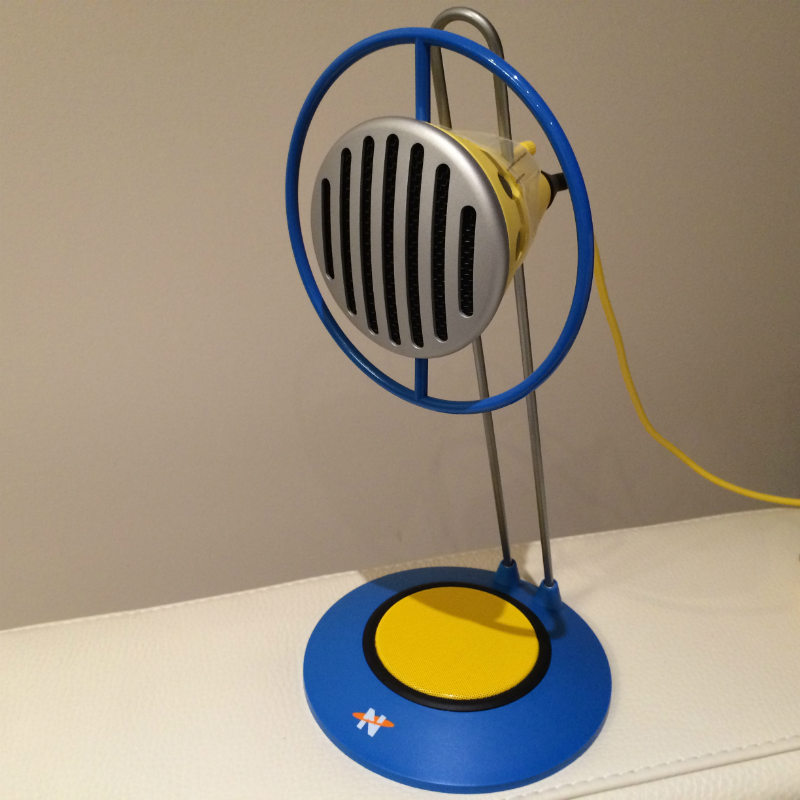 Although physically different, both of these microphones share the exactly the same specifications. This time around, the bee theme is replaced with what looks like a couple of microphones from the 50s thrust into an episode of the Jetsons. Their cartoony appearances are fun to look at and will enhance any vlogger’s style. It is unfortunate that their designs sacrifice adjustability: after loosening the thumbscrews, the microphones can only slide up and down their inclined rails. This limits musical applications and puts emphasis on speech recording. Mostly made out of plastic, the Widgets feel a bit less solid than their bee inspired cousins. The internal shock-mounts and integrated pop-filters add value to the reasonably priced mics. Due to the lack of a dedicated headphone output and gain control, inexperienced users might run into feedback problems with their computer’s speakers.
Although physically different, both of these microphones share the exactly the same specifications. This time around, the bee theme is replaced with what looks like a couple of microphones from the 50s thrust into an episode of the Jetsons. Their cartoony appearances are fun to look at and will enhance any vlogger’s style. It is unfortunate that their designs sacrifice adjustability: after loosening the thumbscrews, the microphones can only slide up and down their inclined rails. This limits musical applications and puts emphasis on speech recording. Mostly made out of plastic, the Widgets feel a bit less solid than their bee inspired cousins. The internal shock-mounts and integrated pop-filters add value to the reasonably priced mics. Due to the lack of a dedicated headphone output and gain control, inexperienced users might run into feedback problems with their computer’s speakers.
Plugged in, the Widget performed well. Like the other Neat products reviewed here, it is a detailed condenser microphone that reflects well the sounds that it captures. Speech recordings were clear and detailed. Thanks to the pop-filter, unwanted consonants weren’t jumping out and everything sounded level. My acoustic guitar came out clear, but with a noticeable lack of body. This was mitigated when I repositioned the Widget to benefit from the proximity effect (this is when bass frequencies are increased when a source is very close to a directional microphone). Unfortunately, playing became really uncomfortable at that point because of the microphone’s rail design.
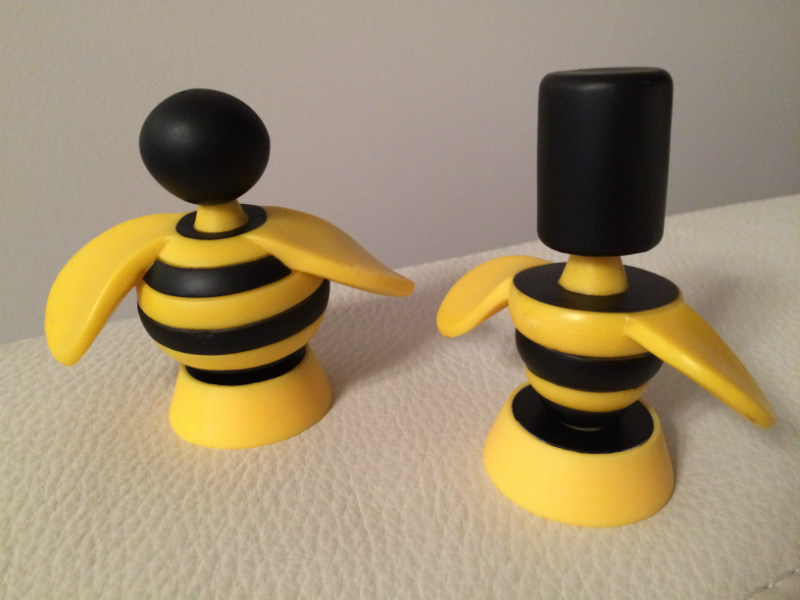 The highlight of these products is definitely their coolness factor. With their solid construction and useful additional features, both bee microphones represent excellent value. The Bumblebee would be the perfect companion for anyone interested in podcasting, vlogging and video conferencing. The Beecaster is a great and versatile mic for recording various instruments thanks to its large diaphragm and built-in stereo imaging. However, if you are just looking for an affordable, stylish and suitable tool to start recording speech, both Widgets are good choices in their price range.
The highlight of these products is definitely their coolness factor. With their solid construction and useful additional features, both bee microphones represent excellent value. The Bumblebee would be the perfect companion for anyone interested in podcasting, vlogging and video conferencing. The Beecaster is a great and versatile mic for recording various instruments thanks to its large diaphragm and built-in stereo imaging. However, if you are just looking for an affordable, stylish and suitable tool to start recording speech, both Widgets are good choices in their price range.
Best Buy will soon have all of these microphones available. Check out the entire selection of musical instruments and recording equipment online.

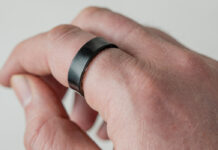


I might have to take a look at the Bumblebee. I really like the sound of that music setting for doing voiceovers.
Comments are closed.